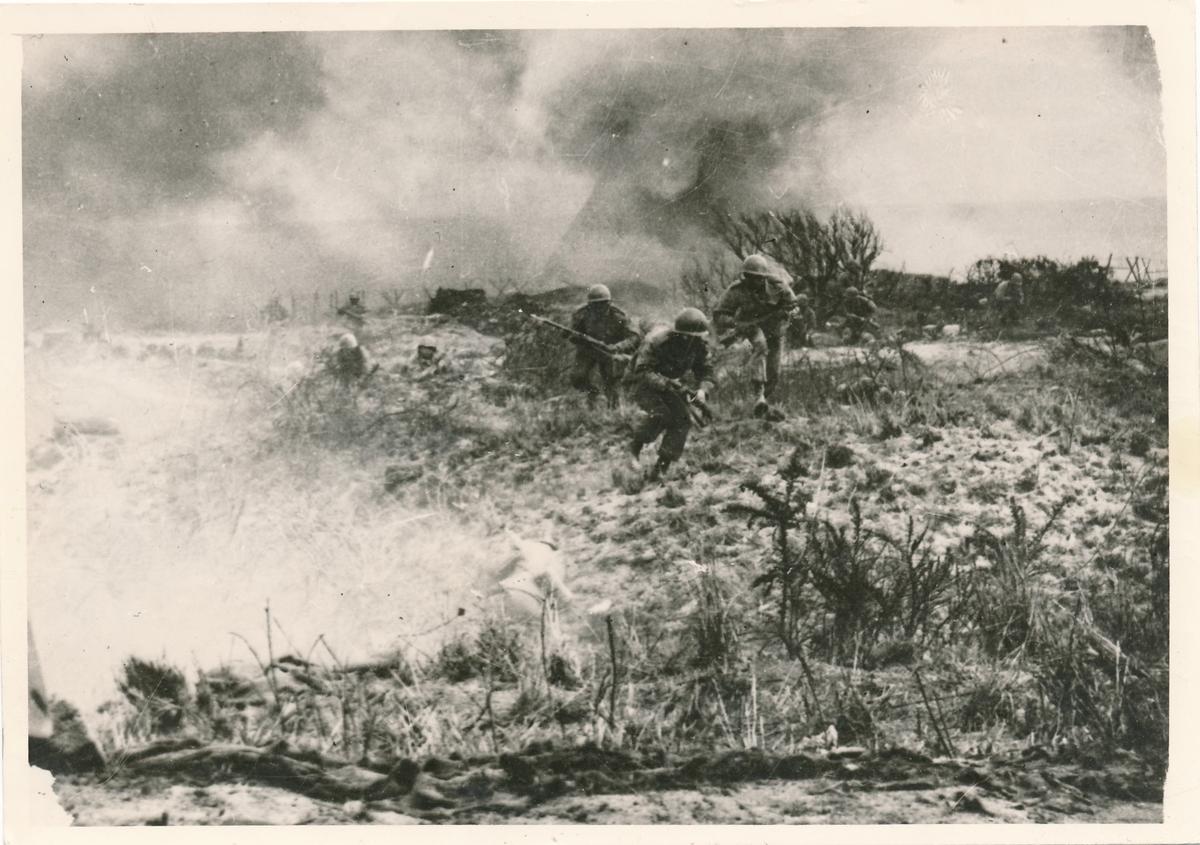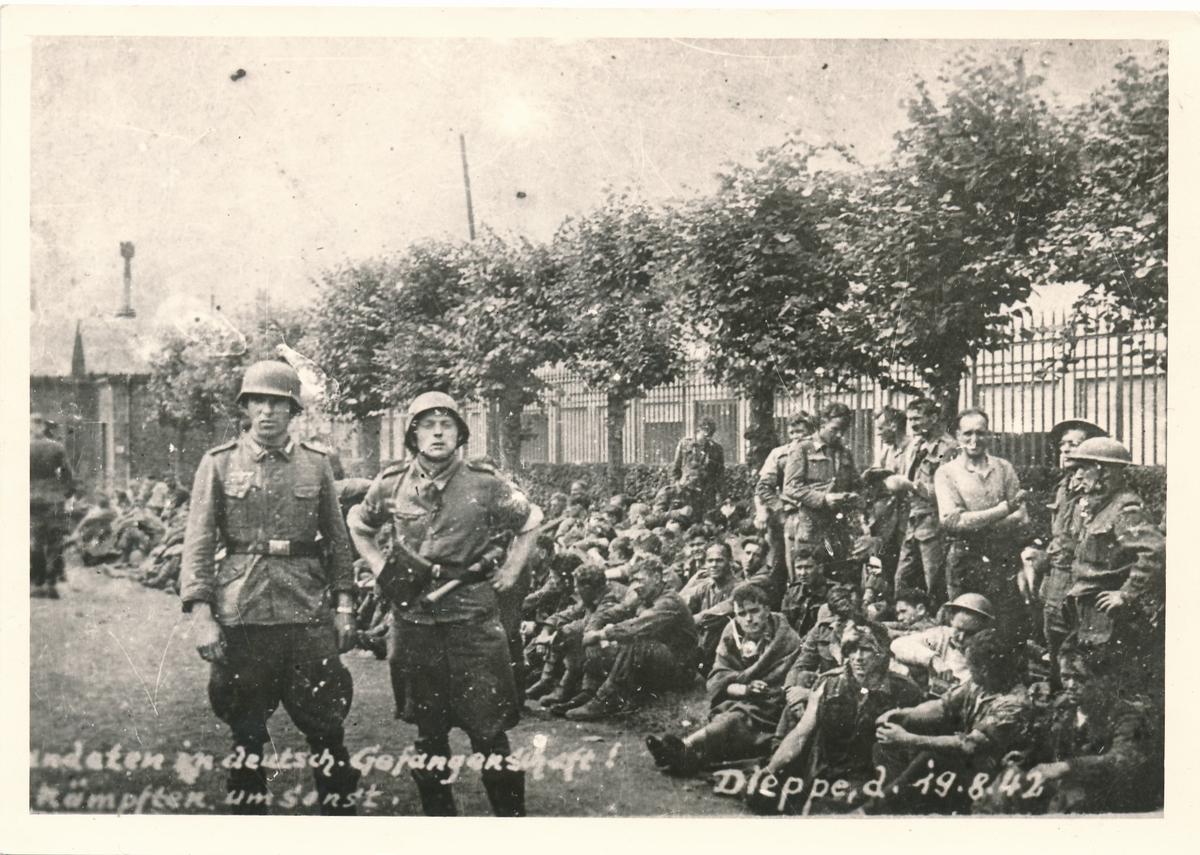The Essex Scottish Regiment in the Dieppe Raid

Infantry of the Essex Scottish Regiment storming the beaches of Dieppe
On 19 August 1942, the 2nd Canadian Division supported by Allied commandos, navy and air forces conducted a raid the heavily defended port town of Dieppe, France. Much has been written about the Dieppe Raid, but it was a complete failure from a tactical point of view. Between the beachhead and the seawall, heavy German artillery, mortar and machine gun fire killed and wounded hundreds of Canadian infantry and engineers and immobilized the tanks. In less than six hours, more than a thousand soldiers were killed. Of the 6,086 Canadian and Allied soldiers that landed at or near Dieppe, only 2,463 would evacuate back to England's shores; the rest were either killed or taken prisoner. In comparison, German casualties amounted to just under sixty. The raid on Dieppe was the largest military catastrophe of the war for the Canadian military and the western Allies.
1st Battalion The Essex Scottish Regiment (ESR) was tasked with assaulting Red Beach on the eastern half of the beachfront near the harbor. The battalion consisted of 553 infantrymen and medics led by Commanding Officer, Lieutenant-Colonel Fred Jasperson. The ESR fought valiantly in the assault landing. Against all odds, the battalion pushed up the beach through withering German artillery, mortar and machine gun fire to the safety of the sea wall. Two small elements of the ESR advanced into the town. These would become the farthest advances of any unit in Dieppe. Moral was high among the men of the ESR throughout the fighting in Dieppe. According to Private Eugene Cousineau, men of the ESR were “fighting like the devil” and their officers were “as brave as any man could be.” Cousineau reported that men at the seawall were smoking cigarettes and pipes, joking, and “making bets on who’d get it next.” Although the ESR performed courageously and retained their composure, they took heavy casualties. At the end of the battle, the Essex Scottish returned to England with only 51 survivors including 27 wounded. The others consisted of 121 killed and 388 prisoners of war.
The men of the ESR had never participated in an amphibious assault against an enemy force before Dieppe. The Regiment were drilled in embarking and disembarking landing craft, night landings, and beach assaults on the Isle of Wight for months before the eventual landings. Much of this training was for Operation RUTTER originally planned for 20-21 June, postponed to 4 July and cancelled on 7 July due to poor weather. Strict secrecy was maintained during the training exercises. Once the operation was cancelled the troops were sent back to their barracks and secrecy protocols were removed.
In the following weeks, off-duty soldiers talked with their peers about the cancelled raid of Dieppe. These conversations in pubs, restaurants, and on the street were undoubtedly heard by German spies and reported to their “handlers” though many of these spies would be captured by British counterintelligence. Furthermore, stories about training for a raid on Dieppe appeared in commonwealth newspapers a full month before the attack took place. German intelligence learned about the cancelled plan to raid Dieppe. British planners soon discovered that the plans had been compromised but instead of cancelling Operation JUBILEE on Dieppe, British command proceeded with the plan with relatively minor adjustments. Vice Admiral Louis Mountbatten, chief planner and architect of the Dieppe Raid, said that "the very last thing they'd (Germans) ever imagine is that we would be so stupid as to lay on the same operation again." The decision to proceed with the raid on Dieppe resulted in thousands of casualties and doomed thousands more to imprisonment in German prison camps.
Despite several earlier raids on German occupied ports, JUBILEE was by far the biggest and most ambitious assault. Using the weather and tide as a guideline, planners at German central command predicted the time and location of a potential Allied raids in 1941. Areas which were seen to be vulnerable to a raid were then reinforced with additional infantry, artillery, and defensive obstacles. In July 1942, a month before the raid occurred, German intelligence received confirmation that a raid at Dieppe was being prepared. Furthermore, on the early morning of the raid a German escort flotilla in the English Channel spotted and engaged British landing crafts travelling to Dieppe. As the raid was launched, German destroyers and naval radar stations warned defending soldiers of the imminent invasion. German infantry and artillery crews arrived at their combat positions a full hour before the first Canadians hit the beach. Meanwhile, British planners launched the operation confident that the “element of surprise” would make up for the plan’s shortcomings. The raid on Dieppe was a failure before it had begun.
The resulting calamity was due to insufficient naval gun fire, lack of heavy bomber support, overly ambitious sequenced landings and timings, inaccurate intelligence and lack of proper secrecy protocols. The Scottish landed at 5:25 a.m. but had 30% casualties by 5:45 a.m. and 75% casualties by 6:30. It would take two years to reconstitute and retrain the ESR back to full strength. Many reinforcements came from the Kent Regiment in Chatham-Kent. The rebuilt Essex Scottish Regiment would not see combat again until Normandy in July 1944. The thousands of Canadians taken prisoner would not be liberated until April 1945. Their memories of living in German prison camps and deadly forced marches across Europe in the final stages of the war would haunt many for the rest of their lives. Though many former POWs returned to Canada after the war, most would never tell their stories.
It has been said that everyone in Windsor at the time felt a personal impact as a family member, friend or acquaintance of an Essex Scottish soldier that was killed, wounded or captured at the 1942 Dieppe Raid.
Story by Calvin Barrett, Canada Summer Jobs 2022 participant
with The Essex and Kent Scottish Regiment Association
Sources
- Battalion leadership in the Essex Scottish Regiment and the 4th Canadian Infantry Brigade during the Second World War, by John James Maker, 2004
- Duty Nobly Done, The History of The Essex and Kent Scottish Regiment by Sandy Antal and Kevin R. Shackleton, 2006 – Chapter X, Chapter Y
- 1st Battalion The Essex Scottish Regiment 1939-1945 booklet (1946)
- Windsor Star, August 27, 1942

German photographs of Canadian prisoners of war being marched through the streets of Dieppe

German officers pose with Canadian prisoners of war captured after the Raid on Dieppe
